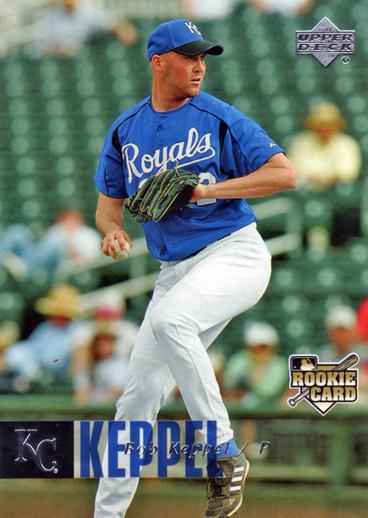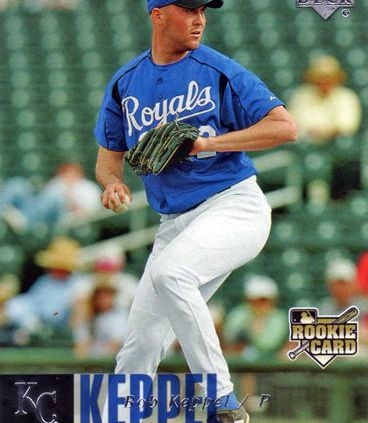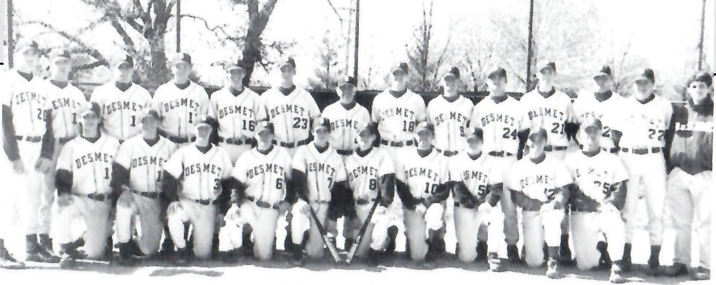Bobby Keppel
 The list of cities he played in reads like Hank Snow’s popular 1962 country hit, “I’ve Been Everywhere.” In 14 years of professional baseball, Bobby Keppel pitched for 14 different teams. Although the grass did not grow under his cleats anywhere for long, Keppel made the big leagues with the Royals, Rockies, and Twins (2006-2009), a testament to some pretty good stuff. The right-hander’s lone big-league win came in a one-game playoff for Minnesota that determined the AL Central winner in 2009.
The list of cities he played in reads like Hank Snow’s popular 1962 country hit, “I’ve Been Everywhere.” In 14 years of professional baseball, Bobby Keppel pitched for 14 different teams. Although the grass did not grow under his cleats anywhere for long, Keppel made the big leagues with the Royals, Rockies, and Twins (2006-2009), a testament to some pretty good stuff. The right-hander’s lone big-league win came in a one-game playoff for Minnesota that determined the AL Central winner in 2009.
Born Robert Griffin Keppel on June 11, 1982, in St. Louis, Missouri, Keppel grew up surrounded by good baseball. His hometown Cardinals won three National League pennants before he turned 6. He was the third of Curt and Denise (née DeWulf) Keppel’s four children, the only son among sisters Erin, Tricia, and Katy. Curt founded Mid-America Lawn Maintenance, a landscaping business, the year Bobby was born.
Keppel’s elementary school was Incarnate Word in the suburb of Chesterfield. While he was at Parkway Central Middle School, he began his experience in youth baseball with the Midwest Comets, one of the first solely travel teams in the nation. The Comets (later called the St. Louis Prospects) travelled extensively to tournaments each summer with gifted area players, and Keppel and his teammates gained valuable experience through their high school years. The team still functioned as of 2021 under owner Andy Benes. Max Scherzer is one of the many Prospects who were drafted and reached the majors. Due to the success of the Comets/Prospects, the notion of travel-intense, league-less youth baseball clubs gained more consideration at the expense of historically dominant leagues like American Legion. The trend continues to affect younger age groups and other sports.
Keppel attended De Smet Jesuit High School in Creve Coeur, Missouri. De Smet had previously shaped one other major leaguer, Bill Mueller. Varsity coach, Greg Vitello, recalled, “When I first saw Bobby, it was a middle school baseball camp. For his age, he was bigger than most kids. He had great athleticism and footwork which struck me right away. At De Smet, I could see by his mannerisms that he took the game seriously. Practice meant something to him. Every time he took the field it meant something to him.”1 Although he was scouted as a pitcher, Keppel played nearly every position on the field and hit a school record nine home runs as a junior. In 1999, he traveled to California for the Area Code Games, a multi-day, summer baseball showcase for the nation’s best underclassmen.
De Smet baseball team. Bobby Keppel is back row, fourth from right.
In addition to baseball, Keppel was a Second Team All-American point guard for De Smet’s basketball team. The Spartans won state championships in basketball during his junior year and baseball when he was a senior. An excellent student, Keppel also earned scholar athlete status for his exceptional grade point average.
Impressed by his 8-2 record and 1.78 ERA as a senior, the New York Mets drafted Keppel in the first round (36th overall) of the 2000 June Amateur Draft. Keppel had already agreed to pitch at Notre Dame, alma mater of both of his parents, but the $1 million that the Mets offered convinced him to turn pro.2 Notre Dame coach Paul Mainieri lamented, “We obviously saw some great potential in Bob when we signed him last fall and he continued to impress the scouts when the spring season rolled around.”3 Keppel attended the school during off-seasons. He explained, “In the minor leagues, I would play from early summer until August. I would then drive to Notre Dame for the fall semester. I would leave for a stint in the instructional league and then come back and take my finals. It was hectic.”4
Keppel joined New York’s Rookie-level, Appalachian League affiliate in Kingsport, Tennessee, for eight games (six starts) in 2000. His ERA was 6.83, but it was simply a stepping-stone to Class A ball the following season. With the Capital City (SC) Bombers of the South Atlantic League in 2001, he was 6-7 with a solid 3.11 ERA in 124 1/3 innings.
As he’d hoped, Keppel advanced to the high Single-A Florida State League in 2002. His workload increased to 152 innings with the St. Lucie Mets, and he set a career high with 109 strikeouts to go with a 9-7 record and 4.32 ERA. The 6-foot-5 Keppel was reaching 93 on his fastball and continued to improve his velocity as playing weight increased to 215 pounds.
In 2003, Keppel made three starts, going 2-0 with a 2.57 ERA, for the Brooklyn Cyclones of the short-season, Single-A New York-Pennsylvania League, but spent most of the year in Double-A. His 7-4 record in the Eastern League included a 99-pitch no-hitter on August 2, the first in Binghamton (NY) Mets’ franchise history. His strikeout-to-walk ratio remained better than 2:1 and his 2.97 combined ERA was his best mark yet. “Keppel is a three-pitch pitcher. He has the changeup, curveball and the fastball. He mixes it up and he does it effectively,” Cyclones manager, Tim Teufel said. “He’s a pitcher and not a thrower. He works the corners, keeps his fastball down and commands the strike zone.”5 Keppel was feeling confident, “It’s always a great opportunity to play with this organization and I can see myself in another year having a shot with the big club. You never know but that’s what I’m really hoping for.”6
After one inning in the Arizona Fall League, however, Keppel was shut down with shoulder soreness.7 Following two exceptional starts back at St. Lucie to begin 2004, he spent the bulk of the year with the Triple-A Norfolk (VA) Tides of the International League. His 3-7 record and 4.71 ERA were disappointing and more shoulder problems ended his season in August. When his shoulder continued bothering him with the Tides in 2005, the Mets released him after only five starts on May 16 to clear a spot on their 40-man roster.
That winter he signed a minor league deal with the Royals and opened 2006 with their Triple-A American Association affiliate in Omaha, going 6-7 with a 5.67 ERA in 25 games. When the Royals called him up, he made his major league debut against the Tigers on May 25, relieving starter Denny Bautista in the fourth inning, protecting a 6-5 lead with two out and two runners on base. Using his signature sinking fastball, Keppel retired Carlos Guillen –a .320 hitter in 2006, delighting the 11,488 at Kauffman Stadium. In the fifth, he whiffed Omar Infante for his first major league strikeout. Keppel went on to pitch 3 1/3 innings of one-run ball and would have been the winning pitcher had Detroit not rallied to victory after he departed.
Another quality relief appearance three days later earned Keppel his first start, on June 2 in Seattle. He went 6 2/3 innings and allowed only two runs, but lost because he received zero runs of support. His next start was brilliant–eight innings with one earned run allowed against the Rangers– but Kansas City’s bullpen blew the lead in the final inning. Keppel’s early success evaporated, however. After four more challenging starts drove his ERA up to 5.50, he returned to Triple-A with an 0-4 record.
Keppel was on the move again that offseason. The Colorado Rockies picked up the righty and assigned him to the Triple-A Colorado Springs Sky Sox to start 2007. When the Rockies’ pitchers struggled early, however, he was back in the big leagues before the end of April. “We had to fill some voids,” Rockies manager Clint Hurdle said. “Keppel provides us with some depth.”8 With an 11.25 ERA in four relief outings, he returned to the Pacific Coast League for the remainder of the season, where he mostly started and pitched to a 5.48 ERA while going 8-10.
A free agent again that offseason, Keppel signed with the Florida Marlins in November. He spent 2008 back in the PCL as a starter with their Albuquerque Isotopes affiliate. Despite working 159 1/3 innings, his 9-11 record, 5.99 ERA and 26 home runs allowed failed to turn heads. Released again, he signed with the Minnesota Twins. who sent him to Rochester in the International League. “Bobby was a fierce competitor—very talented young man. His talent didn’t necessarily overshadow you, but he was able to make the most out of his ability,” recalled Rochester’s manager, Stan Cliburn.9 Making all but three of his 23 appearances in relief, Keppel was 3-3 and lowered his ERA to a respectable 2.43, which earned him another shot at the majors when the Twins’ bullpen struggled. He made his Minnesota debut on June 27, hurling four scoreless innings of relief against the Cardinals in his hometown. “He’s been throwing the ball very, very well,” Twins manager, Ron Gardenhire remarked. “We liked his sinker in spring training. He’s a big guy. If he uses his sinker like that up here, he’ll probably be able to get them out up here too.”10
Keppel earned a regular role with the Twins, having allowed zero earned runs in his first 11 2/3 innings and a mere 0.56 ERA across his first seven appearances. Meanwhile, while the Twins had hovered around .500 when he joined the club, crept toward contention in the American League Central. Minnesota played well down the stretch, winning their final four games to tie the Tigers, who had led by seven games in early September.
Minnesota hosted a one-game playoff for the division title. Game 163 was an instant classic, featuring lead changes, high dramatics, and a 12th-inning walk-off win for the Twins. Keppel entered a tie game with two outs in the 11th and retired Placido Polanco. In the 12th, he loaded the bases with one out, but induced a Brandon Inge grounder to second baseman Nick Punto, who threw home to force out the potential go-ahead run. Next, Keppel struck out Gerald Laird to end the threat. When the Twins scored in the bottom of the inning, Minnesota advanced to the Division Series and Keppel had his first (and only) major league victory. He didn’t pitch while Minnesota was swept in three games by the Yankees.
Released by the Twins in January, Keppel was faced with the choice of continuing as an MLB journeyman or joining Nippon Professional Baseball as a starting pitcher, an opportunity to support his growing family financially and resurrect his major league career. Signed by the Hokkaido Nippon-Ham Fighters of the Japan Pacific League, he pitched to a 3.35 ERA in 158 2/3 innings in 2010. With a 12-8 record, he tied Yu Darvish for second on the team in victories.
The adjustment to Japan was pleasant. Keppel’s family lived in northern Japan and attended local schools. The fan base was very strong, and Keppel was treated as more of a celebrity than he was accustomed to in the United States. He returned to the Fighters in 2011 and enjoyed similar success, a 14-6 record and a 3.18 ERA in 26 starts. Pitching was the second-place club’s strength, with Darvish, Brian Wolfe and Masaru Takeda complementing Keppel in the rotation.
Keppel signed a $1.1 million deal to return to Japan with a chance to become the Fighters’ ace in 2012 after Darvish signed with the Texas Rangers.11 “I’m often asked if I’m going to step up my game, and to be honest, I can’t do anything different.” he remarked during spring training, adding, “I want to be able to go deeper [into games]. There were times last year I could have gone deeper, but our bullpen was doing so well they wanted to hand the ball over to them. Maybe in those situations this year, I’ll keep the ball to give them more rest.”12 Unfortunately, Keppel injured his shoulder after two starts, resulting in season-ending surgery. Nevertheless, the Fighters re-signed him to a one-year contract for 2013, anticipating he could rebound. Keppel made his first start in July after his rehabilitation extended into the beginning of the season, but struggled to regain his previous success, going 2-5 in eight starts.
On January 3, 2014, Cincinnati Reds general manager Walt Jocketty signed Keppel to a minor league deal, hoping he could recover his pre-injury form. Keppel’s father was suffering from cancer at the time. When Curt Keppel requested help running the family lawn care business, Bobby decided to end his professional baseball career.13 In addition to his 1-5 record in 49 major league games, Keppel was 57-60 in 208 minor league outings and 28-23 over four years in Japan.
Away from baseball, Keppel married Suzanne Heil in 2007. Together, they have three girls and three boys. In 2014, the couple started a faith-based magazine, The 9s, that served as a ministry to men before ceasing publication. The Keppels’ Catholic faith is important to them and drives much of their philanthropic work, including marriage preparation and enrichment classes. Other spare time is spent with groups like Troops of St. George and Catholic Athletes for Christ. As of 2021, he continued to operate Mid-America Lawn Maintenance with his father.
As Keppel crisscrossed the world of baseball, he went from admiring players like Ozzie Smith to respecting peers such as David Wright, Mike Sweeney, Joe Mauer, and Adam Wainwright. Through his experience of 14 “home” teams across 14 seasons, the game took Keppel nearly everywhere.
Last revised: March 24, 2021
Acknowledgments
Special thanks to Bobby Keppel, Stan Cliburn and Greg Vitello (interviews with Kevin Bley, 2020).
This biography was reviewed by Malcolm Allen and Norman Macht and fact-checked by Kevin Larkin.
Sources
Statistics are from www.Baseball-Reference.com and www.Retrosheet.org.
Notes
1 Greg Vitello, interview with Kevin Bley, 2020.
2 Frank Cusumano,, “Game On: Bobby Keppel,” Ladue News (Ladue, Missouri), January 31, 2013, https://www.laduenews.com/business/columns/game-on-bobby-keppel/article_0e5b9deb-c064-5bbd-9fd8-1588f2b04c85.html (last accessed January 19, 2021).
3 University of Notre Dame, www.und.com, July 5, 2000, https://und.com/baseball-signee-bob-keppel-opts-for-professional-career/ (last accessed January 19, 2021)
4 Cusumano, “Game On: Bobby Keppel.”
5 Elio Velez, “Working Hard to Join Youth Movement,” Wave (Rockaway Beach, NY), July 4, 2003, https://www.rockawave.com/articles/working-hard-to-join-youth-movement/ (last accessed January 19, 2021)
6 Velez, “Working Hard To Join Youth Movement.”
7 Scott Lauber, “Keppel Finding His Way,” Press & Sun Bulletin (Binghamton, New York), June 22, 2004: D4.
8 Patrick Saunders, “Ramon Ramirez lands on DL,” Denver Post, April 21, 2007, https://www.denverpost.com/2007/04/21/ramon-ramirez-lands-on-dl/ (last accessed December 1, 2020)
9 Stan Cliburn, Interview with Kevin Bley, 2020.
10 Kelly Thesier, “Keppel thrilled about recent callup,” MLB.com, June 24, 2009, http://minnesota.twins.mlb.com/news/article.jsp?ymd=20090623&content_id=5479280&vkey=news_min&fext=.jsp&c_id=min
11 Steve Sypa, “International Free Agent Profile 2014: Bobby Keppel,” https://www.amazinavenue.com/2013/11/14/5049304/international-free-agent-profile-2014-bobby-keppel (last accessed January 19, 2021).
12 John E.Gibson, “Fighters still armed for PL battle without Darvish,” JapaneseBaseball.com, February 17, 2012, http://japanesebaseball.com/writers/display.gsp?id=42695 (last accessed January 19, 2021)
13 Trent Beattie, “Life After Pro Baseball: Unexpected — And Abundant,” National Catholic Register, November 23, 2018, https://www.ncregister.com/interview/life-after-pro-baseball-unexpected-and-abundant (last accessed January 19, 2021)
Full Name
Robert Griffin Keppel
Born
June 11, 1982 at St. Louis, MO (USA)
If you can help us improve this player’s biography, contact us.



